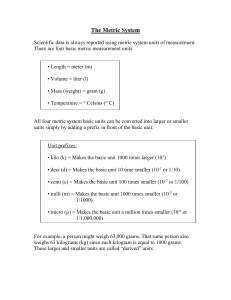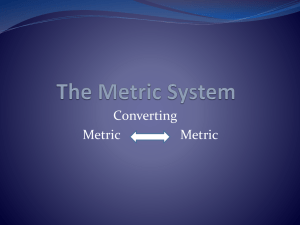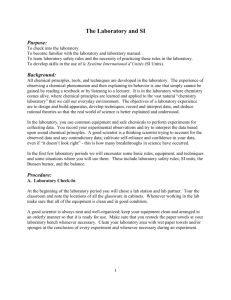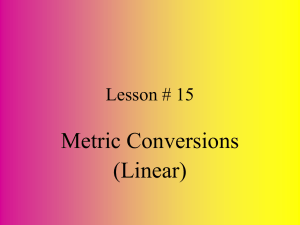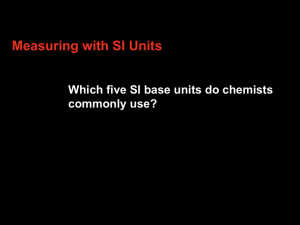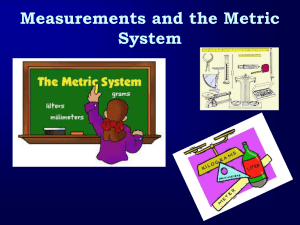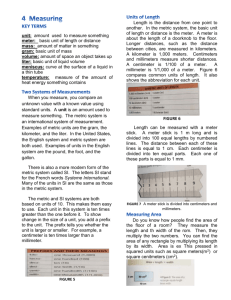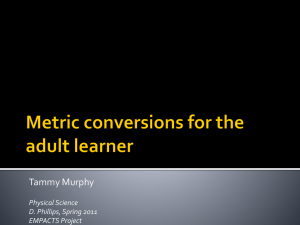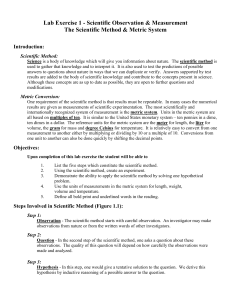Measurements: Accuracy, Precision & Metric System
advertisement
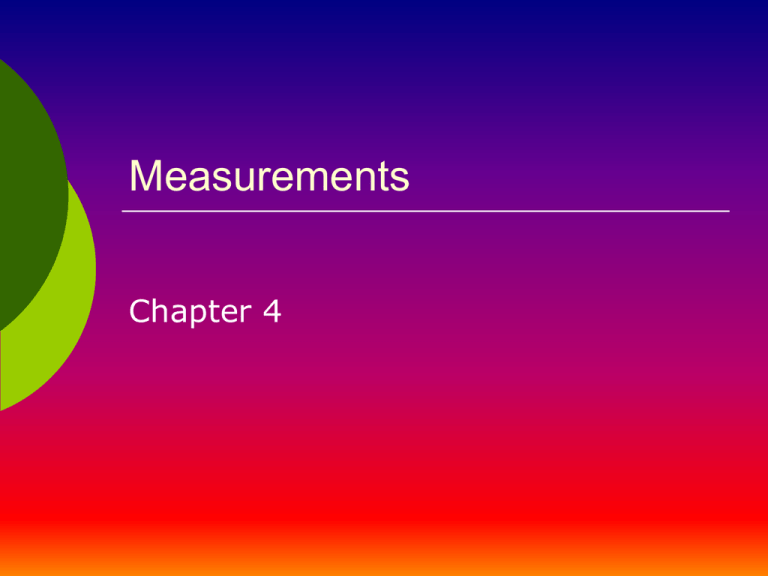
Measurements Chapter 4 Accuracy and Precision Accuracy = how close a single measurement comes to the actual or true value of the quantity measured. Ex. If you need 10 grams of salt, and the amount that you scale registered is 10 grams, then the measurement is considered accurate. Precision = how close SEVERAL measurements are to the same value. Ex. To attain precision, you need to make more than one measurement and compare the results The Metric System Metric System = A common language used all around the world for measurement. Beverages are sold by the liter Food labels indicate the mass in grams Your car has both miles and kilometers Metric Units In the metric system, the unit for measuring length is the meter (m) Gram (g) to measure mass Liter (L) to measure volume Metric Prefixes The metric system is based on the decimal system = numbers are expressed in units of ten. Prefixes are used to indicate what multiple or fraction of the base unit is used in a given situation. These prefixes can be combined with any unit of measure. Ex, the prefix kilo means 1000. Just as 1000 meters is equal to 1 kilometer, 1000 grams equals 1 kilogram and 1000 liters equals 1 kiloliter. The prefixes mili, centi and deci describe fractions of a meter. For example, a centimeter is one one-hundredth (0.01) of a meter. Metric Prefixes Prefix Meaning Numerical Value Unit Example Relationship to Unit Kilo (k) Thousand 1000 Kilometer (km) 1 km = 1000 Deci (d) Centi © Mili (m) Tenth Hundredth Thousandth 0.1 0.01 0.001 Decimeter (dm) Centimeter (cm) Millimeter (mm) 10 dm = 1 m 100cm = 1m 1000mm = 1m Comparison of Metric and English System (Comparison Chart) Metric Unit Symbol Measurement Visualizations English Equivalent Gram Kilogram g kg A little heavier than a paper clip Almost nine sticks of butter 0.035 oz 2.2 lb Meter Kilometer Decimeter Centimeter millimeter m km dm cm mm From the floor to about the doorknob About two-thirds of a mile About the diameter of an average grapefruit Length of a staple Width of a dime 1.09 yards 0.62 miles 3.94 inches 0.39 inches 0.039 inches Liter militer L mL Just over a quart of milk A little less than ¼ teaspoon 1.057 quarts 0.03 fluid oz Estimating As you use the scales on laboratory equipment, make it a habit to estimate to one decimal place past the unit of measure marked on the scale. Ex. suppose you’re using a 100-ml graduated cylinder marked to whole milliliters, and the bottom of the meniscus is between 24 and 25 mL. You would report this as 24.3 mL or 24. 8 mL, depending on how far above 24 mL the volume is. Anyone who reads the data table will know that the last digit is just an estimate, but it will tell them whether the volume was closer to 24 mL or 25 mL. Recording Final Zeros What is the bottom of the meniscus is exactly on the 24-mL line? You need to write 24.0 ML, you make it clear that the volume is exactly 24 mL. By recording the final zero, you report your data more precisely. The rule of recording data also applies to using an electronic balance. Measuring in Metric Measuring Length Use a metric ruler or meter stick Millimeters are generally the smallest division Ex. there are 10mm in 1 cm Each mm line, represents a tenth of a centimeter Measuring Length Measuring Volume Questions 1. 2. 3. 4. 5. 6. 7. 8. Convert Convert Convert Convert Convert Convert Convert Convert 5 inches to centimeters. 4.5 ft. to meters. 45 miles to kilometers. 1 ½ gal. to liters. 4.7 liters to qt. 110 lbs to kilograms. 6oz. to grams. 1.2 acres to hectares. The Celsius Temperature Scale Fahrenheit scale was invented in the early 1700’s by a German physicist, Gabriel Fahrenheit. Anders Celsius, Swedish astronomer developed it in 1742. He used mercury instead of alcohol for making the thermometer more accurate. The scale was formerly called the centigrade scale, which means divided into 100 parts. When measuring temperature, be sure the thermometer bulb is completely immersed in the container, but not touching the sides or bottom. Note that 100 degrees separate freezing and boiling points on the Celsius scale. One the Fahrenheit scale, however the difference is 180 degrees. Therefore a Celsius degree represents almost twice the temperature changes as a Fahrenheit degree. Ch. 4 Questions 1. 2. 3. 4. 5. Can you get precise results when using a faulty thermometer? How are units of measurement related to the base unit in the metric system? What would the measurement “6 dL” tell you about a substance Should you expect to pay more for a qt. of milk or a liter? How many 115-g servings of fish can you get from a 0.75-kg package of fish fillets? Ch. 4 Questions Continued 6. 7. 8. 9. If a graduated cylinder is marked in whole milliliters, why wouldn’t you report a volume as 25.55mL? What is the significance of the zero in the measurement 15.60 g? Generally, how do you choose a measuring device for a given task? Why might you have trouble accurately measuring the temperature of a solid with an English laboratory thermometer?
